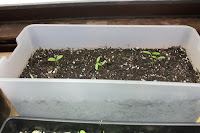11 September 2010
I moved all the vegetable seedlings that made it into 1 gallon pots today. So far in pots I have growing: 3 bell peppers, 1 jalapeno, 1 lemon balm (with 2 sprouts), 1 basil, 1 storage bin of cilantro (3 sprouts). I'm also beginning to realize that the soil depth that I have available in the seed flats (only about an 1.5" isn't going to be enough for the microgreens. The recommended depth is 3-5" and I think once the plants get bigger they won't be able to hold themselves up with only an inch of root depth. I transplanted the half of the flat that was collard greens into some storage bins I had. I'm not sure how well they will do transplanted because they were planted so densely that moving them was kind of difficult (as you can see in the picture) I also started another storage bin (about 6"x6"x1') of new collards to germinate so I'll have a continuous supply of greens as I eat them.
I also measured the electricity usage of my mini fridge today. I plugged the Kill-A-Watt meter in for 24 hours to get a reading of one day of use. It came out to using 22.63 watts/hr, over 24 hours using 0.543 kWh/day. The big fridge uses 68.1 watts/hr (1.68kWh/day). This means that the mini fridge is using less than a third of the energy of the big one! I was surprised about this because I didn't think those little fridges were very energy-efficient, but I'm able to save 1.087 kWh/day now using it. The problem is that I have to be more picky about what gets refrigerated now that I have significantly less space. Apples, pears, yeast, onions and peppers are no longer refrigerated. Instead I have to leave room for the things that absolutely need refrigeration; milk, butter, sunflower oil, eggs, cheese, maple syrup, leftovers. I think we generally over-refrigerate food. While most things will last longer being refrigerated, some foods actually do better without refrigeration. I've started leaving all greens and herbs in glasses of water on the counter instead of putting them in the fridge and they seem to last longer.
This era in history may be remembered as the "Peak Age", a brief time when nearly all materials used to power and create our society reach the maximum extraction and production potential. Past this point, all of these resources become increasingly difficult to extract until they are no longer economically viable resources to be using. There are hundreds of examples of resources, currently embedded in our industrial society, which have reached their peak in the 50 years surrounding 2010, but the one which will most impact our society is petroleum.
The goal of living for 100 days without oil is to understand the extent of our dependance on oil in American society today. Specifically, how it will affect my life, as a 25 year-oil living in Minneapolis, MN. By using myself as a metric I can take a close and conscious look at where oil dependance occurs in all aspects of our daily lives : How we transport ourselves from one place to another, what we eat, how much waste we create, how water is cleaned and transported, where oil is used as; an energy resource, in conventional medicine and for hygiene and how oil affects how we entertain ourselves and communicate with others. By demonstrating how someone would be forced to live without using any oil resources, outlining both what the sacrifices will be as well as the benefits, we can can identify the many systems which will have to be re-designed in a world without cheap oil, and explore a new way of living in which we live in an energy balance.
(At the bottom of this page is a link to my version of a flow diagram of 'Where Petroleum Exists in Our Daily Lives' (using information from the Energy Information Administration-Annual Energy Review 2008 fig 5.0 Petroleum flow) click and zoom to enlarge)








When you open the fridge door, all the cold air "falls" out and room temperature air replaces it. Therefore the fridge has to work harder to cool itself down again. If you fill as much space with bottles of water (or anything for that matter) you increase the thermal stability which means it wont have to work as hard to keep the inside cool after you've opened it.
ReplyDeleteTry to get some dwarf gray sugar snow pea seeds. They mske fabulous greens and will give you substantially more poundage unlike microgreens. Grow them in a similar fashion to your sunflower sprouts, presoaking for 8 hours. They will be ready in 8 to 10 days and are delicious!
ReplyDelete